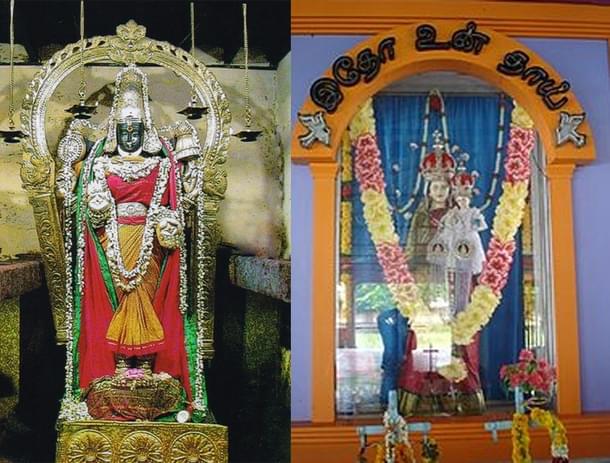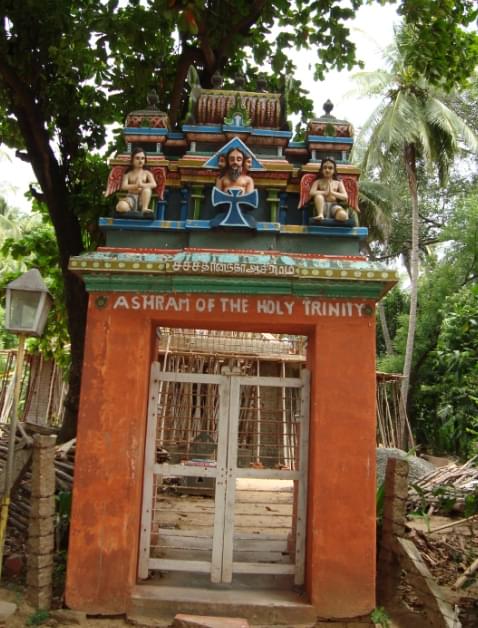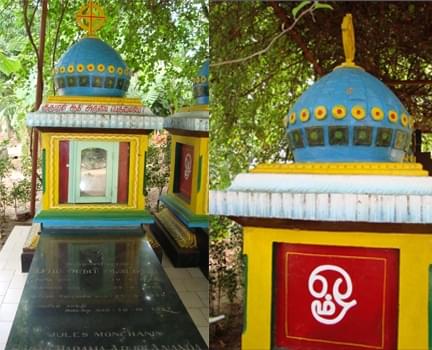Ideas
Appropriation Wars
Aravindan Neelakandan
Nov 24, 2017, 01:35 PM | Updated 01:35 PM IST
Save & read from anywhere!
Bookmark stories for easy access on any device or the Swarajya app.


Recently the Outlook magazine came out with the feature article on inculturation attempts of the Christian denominations in Tamil Nadu particularly by the Catholic church. “This has emanated from the popular devotion of the faithful”, the article quoted Joe Varghese, a Catholic priest of a famous Church of Marian cult in Chennai. Many theologians featured in the article presented the inculturation-evangelical project as ‘cultural inclusiveness’. Are they merely a spontaneous expression of popular devotion and cultural inclusiveness as claimed by the Christian evangelists or is there more to it than what meets the eye?
Let us start from the article itself. In the article, the Christian appropriation of the name ‘Periyanayagi’ by Constanzo Besci, an eighteenth century Catholic missionary in Tamil Nadu, is explained by a Catholic theologian as ‘cultural inclusiveness’. In Tamil Hindu tradition, Periyanayagi is the name of the consort of Shiva. She is a goddess in her own right and is part and parcel of the vital aspect of Shiva. She is primordial and independently divine. She is Brahman. On the other hand, Mary in Christian theology is not even part of the Holy Trinity. She is only a saint – a rank well below the male deity in Christianity. Saints in Christian theology are sort of divine brokers between the devotee and the Christian deity seeking the mercy of the deity for the devout. Thus, when the Catholic church allows the use of the name of a Hindu goddess for Mary, it not only appropriates the name of the deity but also downgrades the name in view of the Christian theological context. It is not inclusive culture. It is theology of aggressive spiritual deceit.

The pattern can be seen continuously in all Christian manoeuvres of the inculturation process and it has a long history. It was the Hindu scholar Sita Ram Goel (1921-2003) who made the first major and systematic study of this Christian phenomenon when he published in 1988 the book Catholic Ashrams. In 1994, an enlarged edition came out. Goel had collected the letters from the promoters and proponents of the inculturation projects as well as its critics – particularly Swami Devananda and Ram Swaroop from the Hindu side and Teasdale and Fr Bede Griffiths from the other side. This work so far remains the best documented work from the Hindu side on this movement. With the inculturation movement today steadily acquiring a popular and theo-political colour it is time we look deep into the theology that forms the basis of the inculturation movement – particularly in Tamil Nadu.

In 1950, Jules Monchanin, a 40-year-old French Catholic missionary, who had been till then ‘unexceptionally’ working in India, succeeded in persuading his church superiors to allow him establish a Christian institution with a Hindu sounding name at the village of Kulithalai near Trichy. In establishing the institution, he had declared that his aim was “nothing less than the assumption into the church of the age-old Indian sannyasa [life of total renunciation] itself.” The mission plan was stated thus:
We would like to crystallize and transubstantiate the search of the Hindu sannyasi. Advaita and praise of the Trinity are our only aim...This means that we must grasp the authentic Hindu search for God in order to Christianize it.(J G Weber, In Quest of the Absolute: the Life and Work of Jules Monchanin (Kalamazoo, Cistercian Publications), p.73.
The Hindu label is only for the Indian evangelical market. Within the hierarchy of the Roman Catholic church it would be listed as a Benedictine monastery. While securing permission from the church, Monchanin had help from French Benedictine monk, Henri Le Saux. The latter in turn got interested in the project and wrote to Monchanin about active collaboration:
We can begin together. I will initiate into life in India, and you will initiate me into Benedictine life, for I strongly agree with you, that [Saint Benedict,] the Patriarch of the West must also, in the plan of God, become the Patriarch of the East.Jules Monchanin quoted in Iona Misquitta, ‘An Ashram in India under the rule of Saint Benedict’ : ‘Jules Monchanin (1895-1957) as seen from East and West Vol-II’, Saccidananda Ashram/ISPCK,Delhi 2001, p.76
![Jules Monchanin [alias] ‘Swami’ Parama Arubi Anandam (1895-1957)](https://swarajya.gumlet.io/swarajya/2017-11/5a1e2a61-41a0-4754-b739-29f1051d400a/moncho.jpg?w=610&q=75&compress=true&format=auto)
Monchanin and Henri le Saux now gave themselves Hindu names. Monchanin became Swami Parama Arubi Anandam (ultimate, formless happiness) and Henri Saux, Swami Abhishiktananda (bliss of the anointed one).
The official name of the institution, inaugurated on 21 March 1950, the feast day of Benedict, was Saccidananda Ashram. which they translated as Hermitages of the Most Holy Trinity’. James Stuart, the hagiographer of Herni le Saux explains the well thought strategy behind the adaptation of the name:

Saccidananda i.e. Sat (being), cit (awareness), ananda (bliss) one of the deepest Hindu insights concerning God, with Trinitarian overtones which are drawn out in Abhishiktananda’s book of the same name.James Stuart, Swami Abhishiktananda : His life told through his letters, ISPCK Delhi:2000, p.35
However, such appropriations of Hindu names in no way diminished the innate aversion towards Hinduism for the missionary in Monchanin. To him, Indian religion was tainted with errors and made vain attempts for salvation. His aim was humbling of Hinduism before Christianity. Making a comparison between pagan Greece and present day India he wrote:
Unfortunately Indian wisdom is tainted with the erroneous tendencies and looks as if it has not yet found its own equilibrium. So was the Greek wisdom before Greece humbly received the Paschal message of the Risen Christ… we hope that India, once baptized to the fullness of her body and soul, and to the depth of her age-long quest for Brahman will reject her pantheistic tendencies and discovering in the splendors of Holy Ghost, the true mysticism and finding a long last the vainly longed for philosophical and theological equilibrium… India has to receive humbly from the Church the sound and basic principles of true contemplation, to keep them faithfully, to stamp her own seal, and develop through them along with the other members of the Church.Jules Monchanin, ‘Contemplation, The essential vocation of the Church and of India’, ‘Swami Parama Arubi Anandam : A Memorial,’ Saccidananda Ashram:2007 p.125
Monchanin simultaneously criticised and tried to appropriate yoga. In 1952, writing on the theme of ‘Christian yoga’, he underlined four ‘perils’ (in upper case) of yoga – ‘physiological, psychological, moral and spiritual.’ Catholic scholar Thomas Matus details Monchanin’s view of yoga thus:
The greatest dangers are of a moral and spiritual order; in both cases, an underlying “Pelagianism” in the various Hindu and Buddhist schools (Monchanin allows very few exceptions to this blanket judgment) seems to subtract yogi from grace; under the illusion that the isolated ego is the Higher Self, the yogi falls prey to the seduction of a monism that allows no room for agapic love.Thomas Matus, ‘Jules Monchanin and Yoga’ in‘Jules Monchanin (1895-1957) as seen from East and West Vol.II‘, Saccidananda Ashram /ISPCK, Delhi 2001, p.113
Despite all these ‘dangers’ and ‘perils’, he does not lose sight of the importance of ‘Christianising yoga’ to the evangelical mission as “(Yoga’s) non-Christianisation would be tantamount to refusing to Christianise India itself”. So to achieve this, Monchanin made a tactful adjustment. Matus explains:
At this point Monchanin makes an important distinction: Yoga does not pertain to the essence of Indian civilization but to its form….Yoga as a ‘method’ not ‘doctrine’ as ‘form-manifestation’ not ‘essence’ would seem to guarantee considerable freedom in a Christian theologian’s assessment of the Yoga component in the various Indian schools, while also guaranteeing a Christian contemplative’s use of yogic forms of meditation.
According to him yoga in its original form excluded grace. Yet Monchanin hoped:
In spite of this accumulation of obstacles, the need remains urgent: if Yoga is not Christianized, an essential aspect of India…will forever remain outside the pleroma of the Mystical Body.
As the inculturation project progressed, important differences started emerging between him and his collaborator Henri Le Saux. The latter wanted to extend Christianising to Advaitic experience also. Towards this end Henri Le Saux took extensive tours to Hindu places of pilgrimage and started practising meditation. Monchanin strongly disapproved of this and warned against going to Rishikesh, which he said was "a place where sadhus, real or supposedly so (both kinds no doubt) devote themselves to delusive exercises verging on mirage".
Monchanin dreaded and detested the non-dualist experience more than anything. This hatred reached new heights as his life neared its end. He wrote:
It seems to me more and more doubtful that the essence of Christianity can be found by going through Advaita (the non-dualism of Sankara). Advaita like yoga and more than yoga is an abyss. Whoever dizzily plunges into it cannot know what he will find in its depths. I fear it may be himself rather than the living triune God.
It is for harbouring this Advaitic vision that Hinduism should die:
In this mystery, Hinduism (and especially advaita) must die to rise up again Christian. Any theory which does not fully take into account this necessity constitutes a lack of loyalty both to Christianity - which we cannot mutilate from its essence - and to Hinduism - from which we cannot hide its fundamental error and its essential divergence from Christianity. Meanwhile our task is to keep all doors open, to wait with patience and theological hope for the hour of the advent of India into the Church ...Hinduism must reject its atman-brahman equation, if it is to enter into Christ.Jules Monchanin, quoted in Harry Oldmeadow, A Christian Pilgrim in India: The Spiritual Journey of Swami Abhishiktananda, World Wisdom. Inc, 2008
Harry Oldmeadow, a sympathetic biographer of Henri Le Saux reveals how this drift was creating some bitterness among the crusaders running the appropriation project:
In later years Abhishiktananda (Henri Le Saux’s Indian alias) himself referred to Monchanin’s skepticism about any reconciliation of Christianity and Vedanta and spoke of Monchanin’s fear that his Christian faith might be overwhelmed by Vedanta as it had nearly been earlier by Greek rationalism. Some hard words on these subjects were exchanged at Shantivanam but their mutual respect and deep affection withstood the strain imposed by these disagreements.
In 1957 Monchanin died and Henri Le Saux took over the ‘ashram’. Even the burial structure over his dead body serves his mission of appropriation. One finds here a verse from Manickavasagar a ninth century Saivaite mystic poet and one of the four seers venerated by Tamil Saivism. The verse written on the grave of Monchanin is the verse in which Manickavasagar speaks of the greatness of Shiva coming as his own guru. The verse when written over the grave of a Christian priest evokes two ambiguous meanings both of which belittle the original Saivaite context.

If one is to take the verse to mean Monchanin himself (by his disciples) then that is a downgrading statement on Shiva to a Christian missionary. If the statement is made as a reference to Jesus then again there is a problem. In Saivism, Siva comes in human form when the disciple has obtained a critical mass of inner preparedness. This human form in which Shiva appears is according to Saivism, is neither an avatar nor does it have a human birth. It is only a form that appears, initiates the disciple and disappears. Hence if the statement of Manickavasagar is applied to Jesus then it is an intentional distortion of the original verse.
Since his death, his project has been safeguarded and nourished. At times his successors had to gloss over his real motives. Bede Griffiths who was the third head of this Catholic institution, positioned himself often as an eclectic Christian who respected Hinduism genuinely. Nevertheless he was as fanatical and scheming but more deceptive than Monchanin. When a knowledgeable Hindu monk Devananda, questioned Bede Griffith’s motives vis-a-vis Monchanin, Griffiths was quick to distance himself and the organisation Monchanin established from the writings of Monchanin:
Thank you for your letter and the enclosure about Father Monchanin. Of course, if I held the same view as Father Monchanin, you would be justified in suspecting me of deception. But you must remember that Father Monchanin was writing forty years ago and immense changes have taken place in the Church since thenBede Griffiths to Swami Devananda letter dated 31-08-1987, in Sita Ram Goel, Catholic Ashrams: Sannyasins or Swindlers,Voice of India 1988:1994, p.135
One can note that in the letter Griffiths tactfully accepted that Monchanin was indulging in deception. And also one can see that the supposed distancing from the deception of Monchanin was attributed by Griffiths, not to any ethical change of heart but rather changes in the establishment of the church. Even this statement by Griffiths is not completely true. The mission of Monchanin still remains very much integral to and is at the heart of Shantivanam movement as evidenced by the fact that the Golden String, the bulletin of the Bede Griffiths Trust in its winter 1997-8 issue hailed Monchanin's quote to “grasp the authentic Hindu search for God in order to Christianize it" as "prophetic".
Today, the strategy of 'Christianisation' of yoga has become even stronger. The seemingly paradoxical stand of Monchanin in outlining the 'perils' of yoga while at the same time taking efforts to Christianise it is reflected in the stand taken by the church at large in India today. Catholic educational institutions do have their own form of yoga curriculum in their schools and campuses. At the same time they oppose any attempt by Indian Government to bring yoga into the school curriculum.
When the present government announced the draft for the National Education Policy in 2016, there was a protest led by Bishop of Coimbatore Diocese L Thomas Aquinas, superintendent of Roman Catholic Schools, Coimbatore Diocese, A Maria Joseph and other high officials of the Catholic church, teachers, non-teaching staff and members of the management of Christian-run education institutions in and around Coimbatore. Among other things the Catholic priests protested against 'promoting yoga', which they declared “was not a panacea for all ills”. The Catholic Bishops Conference of India (CBCI) in its ‘report of the national education consultation' held on 24 and 25 October 2017 in New Delhi, announced that introduction of yoga as also part of “gradual saffronisation".
In other words, here we see how the seemingly abstract theological strategy of Monchanin in Christianising yoga taking concrete political steps in the national discourse. With yoga curriculum decoupled from any state support in the educational system and with the huge network of Catholic institutions free to teach their own versions of yoga, they can soon become the only cost-effective channel for an average Indian child to learn yoga - which of course will initially be merely 'the form' devoid of the authentic spirit of yoga and later acquire a Christian spirit - or Christian yoga.
Aravindan is a contributing editor at Swarajya.





